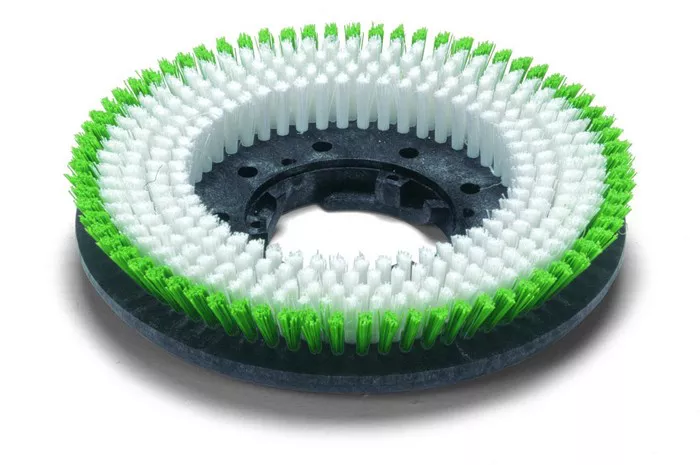Scrubbing and mopping are two common methods employed in floor cleaning routines. Scrubbing typically involves the use of a machine or manual scrubbing with a brush to agitate and remove dirt, stains, and grime from the floor surface. On the other hand, mopping entails using a mop, water, and/or cleaning solution to wipe and clean the floor surface, primarily for routine maintenance.
Effectiveness:
The effectiveness of each method largely depends on the specific cleaning needs and the condition of the floor. Scrubbing is often more effective for tackling stubborn stains, deep-seated grime, and buildup, especially on hard surfaces like tiles, concrete, or textured floors. The mechanical action of scrubbing helps to dislodge and lift dirt from the surface, providing a thorough clean. Conversely, mopping is generally better suited for regular maintenance cleaning, removing surface dust, spills, and light dirt. While it may not penetrate as deeply as scrubbing, mopping can still maintain a clean appearance and upkeep the floor’s condition with regular use.
Time and Effort:
Consideration of time and effort is crucial when deciding between scrubbing and mopping. Scrubbing typically demands more time and physical exertion due to the need for manual labor or operating a scrubbing machine. It’s a more intensive process, especially for heavily soiled areas or stains that require extra attention. On the other hand, mopping is relatively quicker and requires less physical effort, making it suitable for frequent or regular cleaning tasks. Mopping can be accomplished efficiently with minimal training and effort, making it a preferred choice for routine maintenance in many settings.
Types of Surfaces:
The choice between scrubbing and mopping can also depend on the type of flooring surface. Textured or uneven surfaces, such as natural stone, textured tiles, or grouted floors, may benefit more from scrubbing. The mechanical action of scrubbing can reach into crevices and irregularities, ensuring a thorough clean. Smooth surfaces like hardwood, laminate, or sealed concrete may be adequately cleaned with mopping, as the flat surface allows for effective removal of surface debris and dirt.
Equipment and Supplies:
When comparing equipment and supplies, scrubbing typically requires specialized machinery, such as floor scrubbers or scrubbing brushes, along with cleaning solutions tailored to specific floor types and stains. The initial investment in scrubbing equipment and supplies may be higher compared to the basic mop, bucket, and cleaning solution required for mopping. However, mopping equipment and supplies are generally more accessible and affordable, making it a cost-effective option for routine cleaning tasks.
Environmental Impact:
Consideration of the environmental impact is essential in selecting a cleaning method. Scrubbing with machines may consume more water and energy compared to mopping, especially if using high-pressure or industrial-grade equipment. However, advancements in scrubbing technology have led to the development of eco-friendly machines that reduce water usage and energy consumption. Additionally, choosing sustainable cleaning products and methods for both scrubbing and mopping can minimize environmental impact and promote eco-conscious cleaning practices.
Maintenance and Longevity:
Maintenance requirements and the long-term impact on floor longevity should also be considered. Improper scrubbing techniques or overuse of abrasive cleaning solutions can cause wear and tear on floors over time, leading to damage or deterioration of the surface. Regular mopping, when done correctly, helps to preserve the appearance and condition of floors by removing surface contaminants and preventing the buildup of dirt and grime. Implementing a proper maintenance schedule that includes both scrubbing and mopping as needed can extend the life of floors and reduce the need for costly repairs or replacements.
Cost:
The cost associated with each cleaning method includes equipment, supplies, and potential long-term maintenance expenses. Scrubbing machines and specialized cleaning solutions may involve higher upfront costs compared to traditional mopping equipment. However, the investment in scrubbing equipment may yield cost savings in the long run by providing a more thorough and efficient cleaning process, reducing labor costs, and minimizing the need for extensive floor restoration or replacement. Conversely, mopping equipment and supplies are generally more affordable and accessible, making it a budget-friendly option for routine cleaning and maintenance tasks.
Best Practices:
To ensure optimal results and prolong the life of floors, it’s essential to follow best practices for both scrubbing and mopping:
1. Frequency: Establish a regular cleaning schedule based on the traffic and usage of the space. High-traffic areas may require more frequent cleaning, while low-traffic areas can be cleaned less frequently.
2. Techniques: Use proper techniques when scrubbing or mopping to avoid damage to the floor surface. Avoid using excessive force or abrasive materials that can scratch or dull the finish.
3. Cleaning Solutions: Choose cleaning solutions that are compatible with the flooring material and stains being addressed. Test any new cleaning products in an inconspicuous area before widespread use to ensure compatibility and effectiveness.
4. Safety Precautions: When using scrubbing machines or handling cleaning solutions, follow safety precautions to protect yourself and others from potential hazards. Wear appropriate personal protective equipment, such as gloves and eye protection, and ensure adequate ventilation in the cleaning area.
Conclusion:
In conclusion, the choice between scrubbing and mopping depends on various factors, including the type of flooring, level of soiling, time constraints, and personal preferences. Scrubbing is often more effective for deep cleaning and tackling stubborn stains, while mopping is suitable for routine maintenance and upkeep. Ultimately, a combination of both methods, tailored to the specific cleaning needs of the space, is recommended for maintaining clean, hygienic, and aesthetically pleasing floors. By understanding the differences and benefits of each method and implementing best practices, you can achieve optimal results and prolong the life of your floors.

